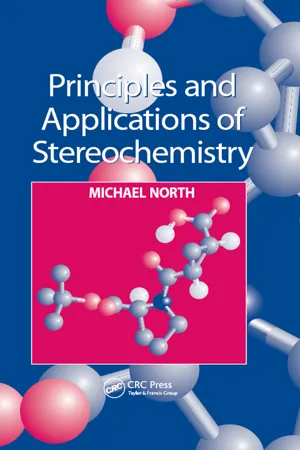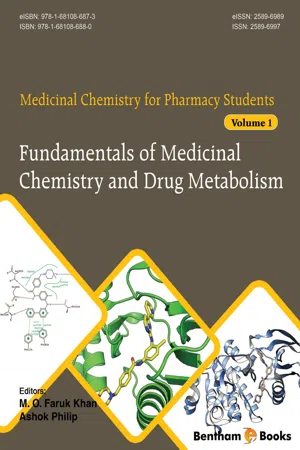Chemistry
Meso Compounds
Meso compounds are molecules with chiral centers that possess an internal plane of symmetry, resulting in overall achirality. This unique property makes meso compounds optically inactive despite having chiral elements. They are often found in organic chemistry, and their internal symmetry allows for distinct stereochemical properties compared to other chiral compounds.
Written by Perlego with AI-assistance
Related key terms
Related key terms
1 of 4
Related key terms
1 of 3
4 Key excerpts on "Meso Compounds"
- eBook - ePub
- Michael North(Author)
- 2017(Publication Date)
- Routledge(Publisher)
Chapter 3 , section 3.4.1). Thus overall, the light ends up in the same plane that it started in and Meso Compounds are not optically active.Table 4.2shows the relationship between structures 4.5 –4.8 of 2, 3-dibromobutandioic acid in terms of their absolute configurations. Structures 4.5 and 4.6 have the opposite absolute configurations at each stereocentre and, as both contain only stereocentres of one absolute configuration (i.e. both R or both S), they are a pair of enantiomers. Structure 4.7 (or structure 4.8 which is identical to 4.7 ), however, contains two stereocentres with the same ligands attached, but of opposite absolute configurations (one R and one S), thus this is the meso isomer.Table 4.2 Absolute configurations of structures 4.5 –4.8Stereocentre Structure 4.5 4.6 4.7 4.8 C𝟚 RSSRC𝟛 RSRSAn interesting example of a meso compound is the dimeric molybdenum complex 4.9 . The structure of this complex was recently determined by X-ray crystallography and it was shown that both molybdenum atoms are stereocentres as they are octahedrally coordinated to six different ligands (cf. Chapter 3 , section 3.7.4). Indeed, structure 4.9 represents the only case of an octahedral metal complex in which the metal atom is coordinated to six different groups which, to date, has been stereochemically characterized. In structure 4.9 - Ahindra Nag, Ahindra Nag(Authors)
- 2018(Publication Date)
- CRC Press(Publisher)
1 Basic Stereochemical Approaches to Natural Products and Drugs Ahindra NagCONTENTS 1.1Basic Concept of Chirality 1.2Meso Compounds 1.3Tautomerism and Valance Tautomerism 1.4Conformation 1.5Fischer Projection and Absolute Configuration 1.6Chiral Resolution 1.6.1Crystal Picking 1.6.2Chemical Separation 1.6.3Biochemical Separation 1.6.4Chromatographic Separation 1.7Application of Enantiomers in Drugs and Natural Products Problems Answers References1.1Basic Concept of Chirality
An asymmetric carbon atom (known as the stereogenic center) is attached to four different groups1 termed a chiral (pronounced as kiral). The word chiral derives from the Greek word cheira meaning hand, which is closely related to optical activity. For a molecule to have chirality, it must not possess a plane, a center, or a fourfold alternating axis of symmetry. Molecules which are mirror images of each other are termed enantiomers (from the Greek entatios meaning opposite) and need chiral recognition to be separated. Enantiomers react1 , 2 , 3 , 4 , 5 , 6 at different rates with other chiral compounds and may have different solubilities in the presence of an optically active solvent. They may display different absorption spectra under circulatory polarized light. Enantiomers may have different optical rotations, which could be either (+), that is, dextrorotatory (clockwise), or (−), that is, levorotatory (anticlockwise), and can be determined by a polarimeter. The optical purity of a mixture of enantiomers is given by% Optical purity of sample = 100 ∗Specific rotation of sampleSpecific rotation of a pure enantiomerwhereSpecific rotationα D=α obs/c lαobs is the experimentally observed rotationc is the concentration in g/mLl is the path length of the cell used, expressed in dm (=10 cm)Enantiomeric excessis one of the indicators of the success of an asymmetric synthesis. The enantiomeric excess (eep7- M. O. Faruk Khan, v Philip(Authors)
- 2018(Publication Date)
- Bentham Science Publishers(Publisher)
L -isomer, which may account for its differential absorption, protein binding and metabolism. Thus, the chirality or stereochemistry of drugs is an important factor to be considered for therapeutic agents. The following sections consider different stereochemical features of drugs. Definitions and illustrations are included to aid in understanding the different conformational and configurational aspects of drugs.Stereochemical Definitions and Illustrations
Isomers are molecules with identical molecular formulas but different structural formulas or different stereochemical formulas and hence different physical and/or chemical properties. Molecules having identical molecular formulas but different structural formulas are termed structural isomers. For example, ethanol (CH3 CH2 OH) and methyl ether (CH3 OCH3 ) are structural isomers as both have the same molecular formula (C2 H6 O), but different connectivity of atoms. Structural isomers would be expected to have very different physical/chemical characteristics (i.e. color, melting point, solubility, etc.).Stereoisomers come about from chirality or from restricted rotation such as in a ring or olefinic (double) bond. There are two obsolete terms that have been used in the past with respect to stereoisomers. The first, optical isomers, is used to describe stereoisomers with different optical properties. These optical properties arise from chirality and will be discussed under that topic. The second, geometric isomers, is used to describe cis-trans isomerism.Chirality is a geometric property whereby a molecule (or any rigid object for that matter) is not superimposable on its mirror image. Chirality arises either from chiral centers or from restricted rotation, referred to as axial chirality. Stereoisomers have identical molecular and structural formulas but they have different spatial arrangements of the same groups. Physical or chemical characteristics of steroisomers are usually different (except see enantiomers).- eBook - ePub
- John Andraos, Albert S. Matlack(Authors)
- 2022(Publication Date)
- CRC Press(Publisher)
10 Stereochemistry
DOI: 10.1201/9781003033615-1010.1 Importance of Optical Isomers
Most organic molecules in living organisms contain asymmetrical centers (i.e., they are chiral). (The terminology of stereochemistry has been reviewed by Moss.1 ) For example, amino acids that are incorporated into proteins are L and sugars in carbohydrates are D. It is understandable that the three-dimensional structures of the receptors in proteins for small molecules will favor only one optical isomer (i.e., the one that fits sterically, hydrogen bonds properly, and so on). Most compounds made for use by plants and animals will have to be single optical isomers. These include agricultural chemicals, drugs, flavors, food additives, fragrances, and such. This is especially important with drugs,2 for which the unwanted isomer may produce toxic side effects.There are several possibilities: (a) The unwanted isomer may be inert, in which case its synthesis is a waste, for it must be discarded or recycled, if this is possible. (b) The unwanted isomer is useful for another entirely different purpose. (c) The unwanted isomer can ruin the effects of the desired one and may prove to be toxic.3 (d) The isomers may racemize in the body so that the racemate may be used. Sheldon has listed some examples (Scheme 10.1 ) that illustrate these cases.4SCHEME 10.1(a) Enantiomers of carvone; (b) enantiomers of aspartame.The reader will appreciate the difference in flavors of the two terpene isomers. Aspartame is the popular artificial sweetener found in many soft drinks and other foods. Dramatic differences can also be found in the isomers of drugs (Scheme 10.2 ).SCHEME 10.2Enantiomers of selected pharmaceuticals along with their biological properties.Some drugs may not need to be single isomers because they racemize in the body. The analgesic ibuprofen (Scheme 10.3 ) is an example. Even so, Merck planned to market the S-isomer as faster acting (12 versus 30 min for the racemic drug).2d
Index pages curate the most relevant extracts from our library of academic textbooks. They’ve been created using an in-house natural language model (NLM), each adding context and meaning to key research topics.
Explore more topic indexes
Explore more topic indexes
1 of 6
Explore more topic indexes
1 of 4



